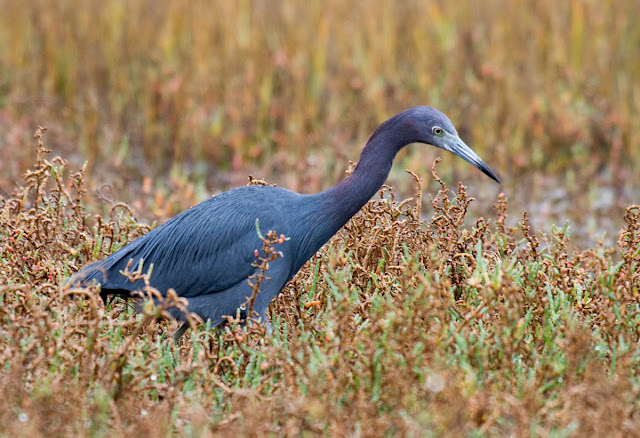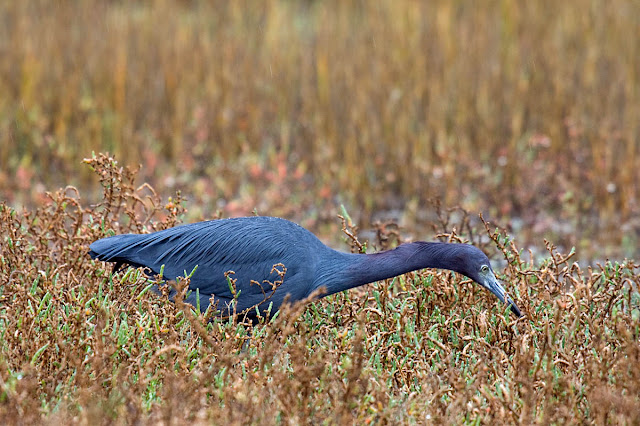I don't know what caused my recent renewed interest in nature journaling. Maybe my bird watching had become superficial--see a bird, identify it, write it down, take a photo, move on. My link to enjoying birds, and thus nature, had simply become a game of tag--I was playing tag by just naming the birds I saw as fast as I could. I wanted something more meaningful; I wanted a deeper connection with not just birds, but all of the natural world.
However it started, by October of last year my decades-long latent interest in nature journaling reached a tipping point. I began watching nature journaling videos on YouTube and bought a couple of books on the subject. I dug through boxes and found the unopened set of quality colored pencils I had been packing around for years. I went to Michaels art supply store and bought graphite pencils and a sketchbook. I was hooked!
And then, toward the end of December, it arrived:
The Laws Guide to Nature Drawing and Journaling. 2016. John Muir Laws. 303 pages. Heyday, Berkeley, California.
Nature Journaling is observing and recording individual organisms in nature primarily by means of words and artwork. Record the date, location, and weather (metadata), and it becomes a simple scientific document. The nature journal can be the foundation for an educational curriculum, teaching science, art, writing and poetry, and mathematics. Or it can just be an enjoyable way to focus your nature observation activities.
Mr. John Muir Laws ("Jack") truly lives up to his famous namesake. And his new book? Fantastic. I studied it cover to cover. And by "study" I mean every day for 21 days I underlined and took notes on every page and followed his art instruction as it pertains to graphite and colored pencils, saving watercolor and gouache for a future time.
Mr. Laws promotes the call to "slow down, observe, discover, and see" with "intentional curiosity." Record your observation in order to...
Notice something you would not have seen;
Remember details you would have forgotten;
Stoke the fires of curiosity and have a tool to explore;
Fall more deeply in love with the [natural] world.
The first 69 pages discuss the nature journaling concept. It discusses different projects one could choose to investigate in their journal, as well as prompts and ideas one could include. Each person's journal is unique, depending upon what they notice in nature and how they respond to it. Mr. Laws stresses that you do not have to be a naturalist or an artist (there's no such thing as an "art gene")--just record and draw what you see and your nature knowledge and art skills ("pretty pictures") will come as an eventual result of practice and prolonged observation and questioning. I love the thought of turning a not-so-good-as-art drawing into a wonderful diagram by adding notes and arrows to it, taking both the attention and the pressure off the drawing, adding density and clarity of information. Every page of Laws' book is packed with examples from his own journals.
Mr. Laws stresses that he struggles with dyslexia. But he doesn't let the sometimes resulting misspelled words shame him from writing in his journal and sharing with others his journal page entries. He thus encourages others to overcome their fear of putting writing or sketches on paper--the writing and artistic skills will develop with practice--anyone can do it.
Page 70 starts a section on the supplies you might want to add to your nature journal field kit--as differentiated from what you might have at home in your "art studio." The emphasis is on easy, quick, and light weight. This allows and encourages you to make quick sketches and notes in the field that you can finish or improve upon later.
Page 84 starts the chapters on nature drawing--an art class! How to draw: Posture, Proportions, Angles. Shading. Color theory (forget red, yellow, and blue as primary colors, it's cyan, yellow, and magenta--just like in your printer). Details. Depth. Contour drawing. Gesture drawing. Negative shapes. Measured drawings. Constructed drawings. Composition.
Then, on page 126 starts media-specific techniques for graphite, colored pencils, ink, water color, and gouache. Laws counsels to find a medium you enjoy and then practice--you don't have to master each medium, though they all begin with a drawing of the underlying basic shape.
Next up, starting on page 154, is How to draw animals, from bugs to salamanders to birds and bears. He covers foreshortening and has many step-by-step instructions. He shows how to create dull and bumpy or smooth and shiny or even iridescent beetles. Slimy salamander skin. Transparent dragonfly wings. Snake scales. Birds from all angles. How to hint at feather groupings rather than drawing every feather so that your bird doesn't turn into a pine cone drawing. He delves into anatomy to show how skin overlays muscles and creates shadows on mammals. How to draw longer fur.
How to draw wildflowers starts on page 220. Trees near and far starts on page 250. Both are covered with the thoroughness of the section on how to draw animals.
Landscapes starts on page 266 with his concept of "Landscapitos," thumbnail landscapes that are fun and fast to add habitat references to your other plant and animal drawings on the page. Rocks. Mountains. Water. Waves. Sky. Clouds. Sunsets. It's all here.
I highly recommend this book!
Who would want this book? Those wanting a closer intimacy with nature, whether already active nature observers or not. Those artistically inclined, wanting to depict the natural world more realistically. Those wishing to receive basic art instruction in nature drawing. Parents of home-schoolers. Grandparents wanting to share art and nature activities with their grandchildren.
Will I keep up this life-changing nature journaling that I have begun? I think so. I hope so. And if I do, I'll have Jack Laws to thank.
Want to explore the Nature Journal idea further? Mr. Laws has a website with blog posts, including many videos of classes he has taught. Nearly everything in the book is in one of these tutorials or videos, but new blog posts and videos are being added constantly. Check it out:
http://johnmuirlaws.com





































